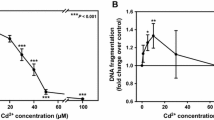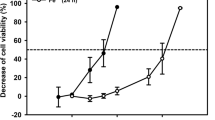Abstract
To clarify the effect of a phytochemical, methyl gallate (MG) on a heavy metal (cadmium)-induced renal toxicity, cytotoxicity and the change of heme oxygenase-1 (HO-1) gene expression was studied using cultured mouse renal glomerular mesangial cells (MMC). By employing RT-PCR and Western blotting analysis, we have examined the HO-1 induction in MMCs that were treated with Cd2+ and/or MG. Using MTT assay we have also examined the cytoprotective effect of HO-1 induction against the cytotoxicity caused by toxic dose of Cd2+. In MMCs exposed to Cd2+ and MG, expression of HO-1 (mRNA and protein) was increased in a concentration- and time-dependent manner. The increments of HO-1 mRNA and protein expressions by Cd2+ and MG were inhibited by the treatment of the cells with actinomycin D, an inhibitor of transcription. The decreased viability of the cells by Cd2+ was partially recovered by the treatment of MG and this recovery by the MG was reduced by the treatment of zinc protoporphyrin IX (a HO-1 inhibitor). From these results, methyl gallate might have cytoprotective effect on Cd2+-induced cytotoxicity that is related with heme oxygenase-1 induction.
Similar content being viewed by others
References
Jarup, L. Hazards of heavy metal contamination. Br Med Bull 68:167–182 (2003).
Sethi, P. K. & Khandelwal, D. Cadmium exposure: health hazards of silver cottage industry in developing countries. J Med Toxicol 2:14–15 (2006).
Singh, B. R. & McLaughlin M. J. Cadmium in soils and plants. In: Developments in Plant and Soil Sciences, edited by McLaughlin MJ and Singh BR. Dordrecht, The Netherlands: Kluwer, 257–268 (1999).
Nomiyama, K. & Nomiyama, H. Cadmium-induced renal dysfunction: new mechanism, treatment and prevention. J Trace Elem Exper Med 11:275–288 (1998).
Tsukahara, T. et al. Rice as the most influential source of cadmium intake among general Japanese population. Sci Total Environ 305:41–51 (2003).
Goering, P. L., Waalkes, M. P. & Klaassen, C. D. Toxicology of cadmium, Toxicology of metals. In Handbook of experimental pharmacology, pp. 189–214. Berlin: Springer-Verlag (1996).
Templeton, D. M. & Chaitu, N. Effects of divalent metals on the isolated rat glomerulus. Toxicology 61:119–133 (1990).
Dorian, C., Gattone II, V. H. & Klaasen, C. D. Renal cadmium deposition and injury as a result of accumulation of cadmium-metallothionein (CdMT) by the proximal convoluted tubules — a light microscopic autoradiography study with 109CdMT. Toxicol Appl Pharmacol 114:173–181 (1992).
Schöcklmann, H. O., Lang, S. & Sterzel, R. B. Regulation of mesangial cell proliferation. Kidney Int 56:1199–1207 (1999).
Liu, Y. & Templeton, D. M. Cadmium activates CaMK-II and initiates CaMK-II dependent apoptosis in mesangial cells. FEBS Lett 581:1481–1486 (2007).
Apostolova, M. D., Christova, T. & Templeton, D. M. Involvement of gelsolin in cadmium-induced disruption of the mesangial cell cytoskeleton. Toxicol Sci 89:465–474 (2006).
Nogué, S., Sanz-Gallén, P., Torras, A. & Boluda F. Chronic overexposure to cadmium fumes associated with IgA mesangial glomerulonephritis. Occup Med (Lond) 54:265–267 (2004).
Badisa, V. L. et al. Cytotoxicity and stress gene microarray analysis in cadmium-exposed CRL-1439 normal rat liver cells. Int J Mol Med 22:213–219 (2008).
Kusakabe, T. et al. Changes of heavy metal, metallothionein and heat shock proteins in Sertoli cells induced by cadmium exposure. Toxicol In Vitro 22:1469–1475 (2008).
Tenhuen, R., Marver, H. S. & Schmid, R. The enzymatic conversion of heme to bilirubin by microsomal heme oxygenase. Proc Natl Acad Sci USA 68:748–755 (1968).
Ottterbein, L. O. & Choi, A. M. K. Heme oxygenase: colors of defense against cellular stress. Am J Physiol Lung Cell Mol Physiol 279:L1029–L1037 (2000).
Srisook, K. et al. Heme oxygenase-1-mediated partial cytoprotective effect by NO on cadmium-induced cytotoxicity in C6 rat glioma cells. Toxicol In Vitro 19:31–39 (2005).
Sue, Y. M. et al. Antioxidation and anti-inflammation by haem oxygenase-1 contribute to protection by tetramethylpyrazine against gentamicin-induced apoptosis in murine renal tubular cells. Nephrol Dial Transplant 24:769–777 (2009).
Wang, D., Zhong, X. P., Qiao, Z. X. & Gui, J. F. Inductive transcription and protective role of fish heme oxygenase-1 under hypoxic stress. J Exp Biol 211:2700–2706 (2008).
Yu, J. B. & Yao, S. L. Protective effects of hemin pretreatment combined with ulinastatin on septic shock in rats. Chin Med J (Engl) 121:49–55 (2008).
Hassoun, E. A. & Stohs, S. Cadmium-induced production of superoxide anion and nitric oxide, DNA single strand breaks and lactate dehydrogenase leakage in J774.1 cell cultures. Toxicology 112:219–226 (1996).
Hwang, D. F. & Wang, L. C. Effect of taurine on toxicity of cadmium in rats. Toxicology 167:173–180 (2001).
Nigam, D., Shukla, G. S. & Agarwal, A. K. Glutathione depletion and oxidative damage in mitochondria following exposure to cadmium in rat liver and kidney. Toxicology Letters 106:151–157 (1999).
Robinson, M. K., Barfuss, D. W. & Zalups, R. K. Cadmium transport and toxicity in isolated perfused segments of the renal proximal tubule. Toxicol Appl Pharmacol 121:103–111 (1993).
Thijssen, S., Maringwa, J., Faes, C., Lambrichts, I. & Van Kerkhove, E. Chronic exposure of mice to environmentally relevant, low doses of cadmium leads to early renal damage, not predicted by blood or urine cadmium levels. Toxicology 229:145–156 (2007).
Kozyraki, R. et al. Megalindependent cubilin-mediated endocytosis is a major pathway for the apical uptake of transferrin in polarized epithelia. Proc Natl Acad Sci USA 98:12491–12496 (2001).
Wang, S. H., Shih, Y. L., Ko, W. C., Wei, Y. H. & Shih C. M. Cadmium-induced autophagy and apoptosis are mediated by a calcium signaling pathway. Cell Mol Life Sci 65:3640–3652 (2008).
Yang, L. Y., Wu, K. H., Chiu, W. T., Wang, S. H. & Shih, C. M. The cadmium-induced death of mesangial cells results in nephrotoxicity. Autophagy 5:571–572 (2009).
Hartsfield, C. L., Alam, J. & Choi, A. M. K. Transcriptional regulation of the heme oxygenase 1 gene by pyrrolidone dithiocarbamate. FASEB Journal 12:1675–1682 (1998).
Zhang, W. L., Tsuneishi, S. & Nakamura, H. Induction of heat shock proteins and its effects on glial differentiation in rat C6 glioblastoma cells. Kobe Journal of Medical Science 47:77–95 (2001).
Bagchi, D., Bagchi, M., Tang, L. & Stohs, S. J. Comparative in vitro and in vivo protein kinase C activation by selected pesticides and transition metal salts. Toxicology Letters 91:31–37 (1997).
Huang, H. C., Nguyen, T. & Pickett, C. B. Regulation of the antioxidant response element by protein kinase-C mediated phosphorylation of NF-E2-related factor 2. Proceedings of the National Academy of Sciences of the United States of America 97:12475–12480 (2000).
He, C. H. et al. Identification of activating transcription factor 4 (ATF4) as an Nrf2-interacting protein: implication for heme oxygenase-1 gene regulation. J Biol Chem 276:20858–20865 (2001).
Choi, B. M. et al. Piperine protects cisplatin-induced apoptosis via heme oxygenase-1 induction in auditory cells. J Nutr Biochem 18:615–622 (2007).
Lee, H. J. et al. Rosmarinic acid protects human dopaminergic neuronal cells against hydrogen peroxideinduced apoptosis. Toxicology 250:109–115 (2008).
Yang, C., Zhang, X., Fan, H. & Liu, Y. Curcumin upregulates transcription factor Nrf2, HO-1 expression and protects rat brains against focal ischemia. Brain Res 1282:133–141 (2009).
Cho, E. J. et al. Study on the inhibitory effects of Korean medicinal plants and their main compounds on the 1,1-diphenyl-2-picrylhydrazyl radical. Phytomedicine 10:544–551 (2003).
Hsieh, T. et al. Protective effect of methyl gallate from Toona sinensis (Meliaceae) against hydrogen peroxideinduced oxidative stress and DNA damage in MDCK cells. Food Chem Toxicol 42:843–850 (2004).
Lim, M. Y., Park, Y. H., Son, D. J., Kim, M. K. & Lee, H. S. Antiplatelet activity of gallic acid and methyl gallate. Food Sci Biot 13:806–809 (2004).
Cho, E. J., Yokozawa, T., Kim, H. Y., Shibahara, N. & Park, J. C. Rosa rugosa attenuates diabetic oxidative stress in rats with streptozotocin-induced diabetes. Am J Chinese Med 32:487–496 (2004).
Kang, M. S., Oh, J. S., Kang, I. C., Hong, S. J. & Choi, C. H. Inhibitory effect of methyl gallate and gallic acid on oral bacteria. J Microbiol 46:744–750 (2008).
Stocker, R., Yamamoto, Y., Mcdonagh, A. F., Glazer, A. N. & Ames, B. N. Biliribin is an antioxidant of possible physiological importance. Science 235:1043–1046 (1987).
Author information
Authors and Affiliations
Corresponding author
Rights and permissions
About this article
Cite this article
Cha, S.H., Suh, C.K. Heme oxygenase-1 mediated protective effect of methyl gallate on cadmium-induced cytotoxicity in cultured mouse mesangial cells. Mol. Cell. Toxicol. 6, 127–133 (2010). https://doi.org/10.1007/s13273-010-0019-0
Received:
Accepted:
Published:
Issue Date:
DOI: https://doi.org/10.1007/s13273-010-0019-0




